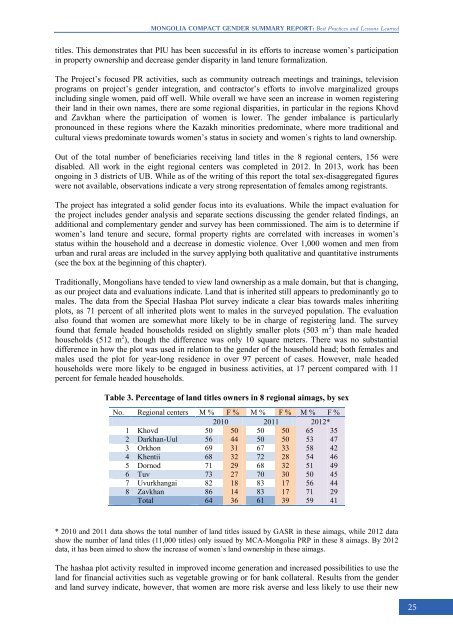Ulaanbaatar 2013
Ulaanbaatar 2013
Ulaanbaatar 2013
Create successful ePaper yourself
Turn your PDF publications into a flip-book with our unique Google optimized e-Paper software.
Mongolia Compact Gender Summary Report: Best Practices And Lessons Learnedtitles. This demonstrates that PIU has been successful in its efforts to increase women‟s participationin property ownership and decrease gender disparity in land tenure formalization.The Project‟s focused PR activities, such as community outreach meetings and trainings, televisionprograms on project‟s gender integration, and contractor‟s efforts to involve marginalized groupsincluding single women, paid off well. While overall we have seen an increase in women registeringtheir land in their own names, there are some regional disparities, in particular in the regions Khovdand Zavkhan where the participation of women is lower. The gender imbalance is particularlypronounced in these regions where the Kazakh minorities predominate, where more traditional andcultural views predominate towards women‟s status in society and women`s rights to land ownership.Out of the total number of beneficiaries receiving land titles in the 8 regional centers, 156 weredisabled. All work in the eight regional centers was completed in 2012. In <strong>2013</strong>, work has beenongoing in 3 districts of UB. While as of the writing of this report the total sex-disaggregated figureswere not available, observations indicate a very strong representation of females among registrants.The project has integrated a solid gender focus into its evaluations. While the impact evaluation forthe project includes gender analysis and separate sections discussing the gender related findings, anadditional and complementary gender and survey has been commissioned. The aim is to determine ifwomen‟s land tenure and secure, formal property rights are correlated with increases in women‟sstatus within the household and a decrease in domestic violence. Over 1,000 women and men fromurban and rural areas are included in the survey applying both qualitative and quantitative instruments(see the box at the beginning of this chapter).Traditionally, Mongolians have tended to view land ownership as a male domain, but that is changing,as our project data and evaluations indicate. Land that is inherited still appears to predominantly go tomales. The data from the Special Hashaa Plot survey indicate a clear bias towards males inheritingplots, as 71 percent of all inherited plots went to males in the surveyed population. The evaluationalso found that women are somewhat more likely to be in charge of registering land. The surveyfound that female headed households resided on slightly smaller plots (503 m 2 ) than male headedhouseholds (512 m 2 ), though the difference was only 10 square meters. There was no substantialdifference in how the plot was used in relation to the gender of the household head; both females andmales used the plot for year-long residence in over 97 percent of cases. However, male headedhouseholds were more likely to be engaged in business activities, at 17 percent compared with 11percent for female headed households.Table 3. Percentage of land titles owners in 8 regional aimags, by sexNo. Regional centers M % F % M % F % M % F %2010 2011 2012*1 Khovd 50 50 50 50 65 352 Darkhan-Uul 56 44 50 50 53 473 Orkhon 69 31 67 33 58 424 Khentii 68 32 72 28 54 465 Dornod 71 29 68 32 51 496 Tuv 73 27 70 30 50 457 Uvurkhangai 82 18 83 17 56 448 Zavkhan 86 14 83 17 71 29Total 64 36 61 39 59 41* 2010 and 2011 data shows the total number of land titles issued by GASR in these aimags, while 2012 datashow the number of land titles (11,000 titles) only issued by MCA-Mongolia PRP in these 8 aimags. By 2012data, it has been aimed to show the increase of women`s land ownership in these aimags.The hashaa plot activity resulted in improved income generation and increased possibilities to use theland for financial activities such as vegetable growing or for bank collateral. Results from the genderand land survey indicate, however, that women are more risk averse and less likely to use their newPage 25 of 8025


